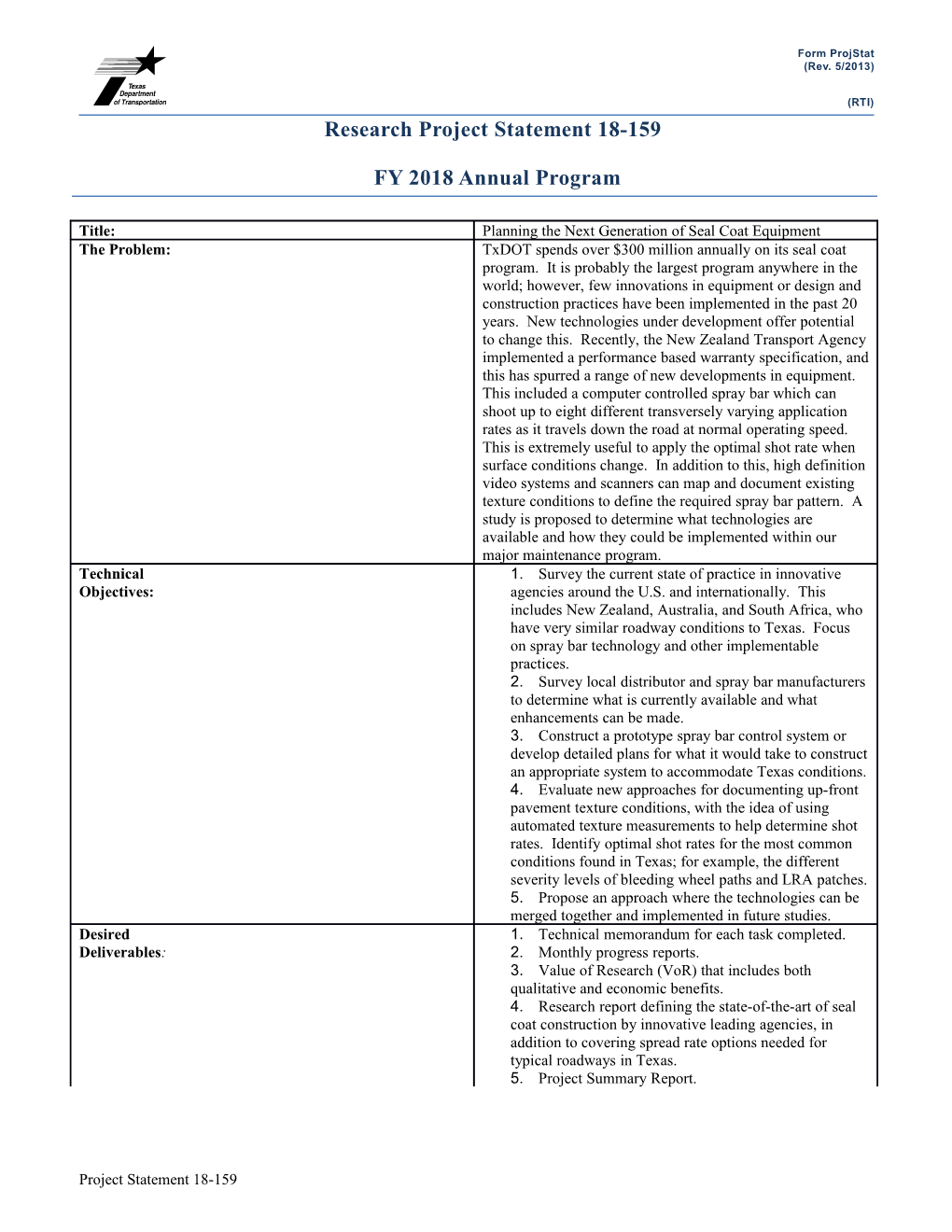Form ProjStat (Rev. 5/2013)
(RTI)
Research Project Statement 18-159FY 2018 Annual Program
Title: / Planning the Next Generation of Seal Coat Equipment
The Problem: / TxDOT spends over $300 million annually on its seal coat program. It is probably the largest program anywhere in the world; however, few innovations in equipment or design and construction practices have been implemented in the past 20 years. New technologies under development offer potential to change this. Recently, the New Zealand Transport Agency implemented a performance based warranty specification, and this has spurred a range of new developments in equipment. This included a computer controlled spray bar which can shoot up to eight different transversely varying application rates as it travels down the road at normal operating speed. This is extremely useful to apply the optimal shot rate when surface conditions change. In addition to this, high definition video systems and scanners can map and document existing texture conditions to define the required spray bar pattern. A study is proposed to determine what technologies are available and how they could be implemented within our major maintenance program.
Technical
Objectives: /
- Survey the current state of practice in innovative agencies around the U.S. and internationally. This includes New Zealand, Australia, and South Africa, who have very similar roadway conditions to Texas. Focus on spray bar technology and other implementable practices.
- Survey local distributor and spray bar manufacturers to determine what is currently available and what enhancements can be made.
- Construct a prototype spray bar control system or develop detailed plans for what it would take to construct an appropriate system to accommodate Texas conditions.
- Evaluate new approaches for documenting up-front pavement texture conditions, with the idea of using automated texture measurements to help determine shot rates. Identify optimal shot rates for the most common conditions found in Texas; for example, the different severity levels of bleeding wheel paths and LRA patches.
- Propose an approach where the technologies can be merged together and implemented in future studies.
Desired
Deliverables: /
- Technical memorandum for each task completed.
- Monthly progress reports.
- Value of Research (VoR) that includes both qualitative and economic benefits.
- Research reportdefining the state-of-the-art of seal coat construction by innovative leading agencies, in addition to covering spread rate options needed for typical roadways in Texas.
- Project Summary Report.
Proposal
Requirements: /
- Utilize the deliverable based templates (see the appendices provided or in the University Handbook)
- Proposals will be considered non-responsive and will not be accepted for technical evaluation if they are not received by the deadline or do not meet the requirements stated in RTI’s University Handbook.
- Proposals should be submitted in PDF format, 1 PDF file per proposal. File name should include project name and university abbreviation.
Pre-Proposal Meeting Information: / Monday, March 27, 2017 10:00AM – 12:00PM
Austin Riverside Campus
118 E. Riverside Dr.
RTI Conference Room, 1st Floor
Webex Information:
1. Go to
2. If requested, enter your name and email address.
3. If a password is required, enter the meeting password: GzDup33h
4. Click "Join".
Teleconference information:
Provide your phone number when you join the meeting to receive a call back. Alternatively, you can call:
Call-in toll-free number: 1-855-437-3563(US)
Conference Code: 734 178 806
Notifying RTI of Intent to Propose: / In order to be notified if additional project information is distributed by TxDOT, you must contact RTI, at (512) 416-4730 or by April 3, 2017, if you plan to propose.
Proposal
Deadline: / Proposals are due to RTI by 4:00 p.m. Central Time, May 11, 2017. Email submissions should be sent to .
Project Statement 18-159
